After spending a few weeks with the Christopher Ward C9 Harrison Jumping Hour watch, I can safely say that I am smitten. Yes, smitten. As a watch lover I can’t help but be seduced by those epic watches that cost from $6 – 600 thousand dollars, but as a normal dude, I never expect to own one. The watches I am talking about are those with really unique little mechanical gizmos under their skin that are doing fascinating little tasks, whether it is tracking the moon or spinning on multiple axis, they are part of what makes watches so fascinating. So, when a watch like the C9 comes along, containing within it one of those unique mechanical complications, but is at an achievable price point, I get really excited. Sure, $1,585 is not cheap, but one could imagine how through saving and perhaps selling off watches one no longer wears, $1,585 is not that out of reach. Having been able to actually spend time with this watch, the answer is yes, the unique complication, as well as the overall high build and detail quality puts the C9 in a league of its own.
scroll down to check out our video review of the C9
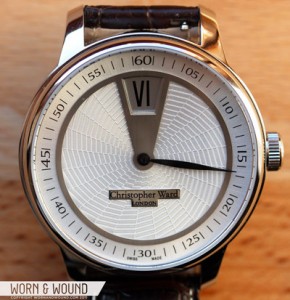 Case: Stainless steel
Case: Stainless steel
Movement: Base: ETA 2824-2 25 Jewel Auto Mod. JJ001
Dial: Galvanic Silver Guilloche Dial
Lens: Domed Sapphire
Case Back: Screwdown
Strap: Louisiana Alligator
Water Res.: 50 M
Dimensions: 43mm
Thickness: 13.5 mm
Lug Width: 20mm
Warranty: 5 years on movement, 60 days free return
Obviously, the most notable feature of the C9 is its jump hour movement, a style of movement that is rare and typically only found in watches that are more expensive. Jumping hour movements have actually been around for some time, dating back to the mid 1800’s. Here is an interesting early 20th century example, a 1930’s Cartier found by Hodinkee. Despite the fact that the concept has been around, they have never been a common offering from brands. Whether this is due to the complexity of the complication, a lack of market desire or simply general trending is hard to say, but it is great to see a revival of the style. Currently, there are a small handful of jumping hours from luxury brands ranging from Baume & Mercier to A. Lange & Söhne available, but they will run you several thousands to tens of thousands of dollars. At close to $3,500 less than the next cheapest model, and featuring an in-house complication, the C9 is clearly something special.
But, what is a jump hour? Basically, a jumping hour watch indicates the hour via a rotating disc, with the current hour displayed through a window in the dial. At exactly 60 minutes the dial jumps forward 30 degrees, indicating the next hour. The overall effect is that of a visual simplification to the watch. The C9 in particular emphasizes this simplicity, by featuring just a minute hand and the hour window. The end result is that the watch is quite serene and extremely easy to read. Within the movement, however, the watch has actually gotten more complex.
 In order to achieve a jumping hour watch, the movement needs a complication that will rotate the hour disc 30 degrees in a snap. This requires additional force as well precise timing (fairly obvious). The trouble is that historically, these movements have been inaccurate. As C Ward points out in the manual that accompanies the watch, due to the additional power requirements needed to jump the hour, additional stress is put on the movement creating inaccuracy. One can understand the logic behind this…think about opening a jammed door. If you pull slowly and steadily, it probably will not open, but if you pull suddenly with greater strength it will. Sudden force is needed to move the disc, which is a heavier load than a normal hand. Typically, these movements would build up power shortly before the disc jumps creating inconsistent power demands from the movement. The complication featured in the C9 builds up power consistently over the hour, resulting in “greater accuracy and reliability”.
In order to achieve a jumping hour watch, the movement needs a complication that will rotate the hour disc 30 degrees in a snap. This requires additional force as well precise timing (fairly obvious). The trouble is that historically, these movements have been inaccurate. As C Ward points out in the manual that accompanies the watch, due to the additional power requirements needed to jump the hour, additional stress is put on the movement creating inaccuracy. One can understand the logic behind this…think about opening a jammed door. If you pull slowly and steadily, it probably will not open, but if you pull suddenly with greater strength it will. Sudden force is needed to move the disc, which is a heavier load than a normal hand. Typically, these movements would build up power shortly before the disc jumps creating inconsistent power demands from the movement. The complication featured in the C9 builds up power consistently over the hour, resulting in “greater accuracy and reliability”.
As part of the mission to design this watch, C Ward sought out to rectify the accuracy issue. To do this, they went to the 27-year-old German watchmaker Johannes Janhke for the complication design. Janke’s innovation was this distribution of power over the full course of the hour. In the manual, C Ward also mentions that they used laser-cutting technology from the medical industry to create some of the components of the complication, which to me signifies the brand’s genuine goal to innovate beyond the expected scope of affordable watches. The resulting module, the JJ001, sits between the base movement and hour dial disk, adding 2.5mm to the movement height. The base caliber of the movement is a decorated ETA 2824-2 automatic movement, which is perhaps the most commonly used ETA automatic movement. The end result is a hybrid of high quality existing Swiss parts, the 2824-2, and a totally unique and proprietary C Ward module.
 Personally speaking, I love the idea of jump hour watches, the semi-digital nature of their layout, the added complexity of the movement and the resultant legibility. They sort of exemplify part of the mystique of the mechanical watch, which is to say that a lot of effort, intelligence, time and discovery, not to mention a lot of little moving parts, go into perfecting something that is relatively invisible or easily taken for granted. When you wear a watch like this, people who might notice it will probably have no appreciation for everything that went into it (unless they are a fellow watch nerd), these details are for you and make this object all the more special… but enough about that, and onto the looks of the C9.
Personally speaking, I love the idea of jump hour watches, the semi-digital nature of their layout, the added complexity of the movement and the resultant legibility. They sort of exemplify part of the mystique of the mechanical watch, which is to say that a lot of effort, intelligence, time and discovery, not to mention a lot of little moving parts, go into perfecting something that is relatively invisible or easily taken for granted. When you wear a watch like this, people who might notice it will probably have no appreciation for everything that went into it (unless they are a fellow watch nerd), these details are for you and make this object all the more special… but enough about that, and onto the looks of the C9.
The C9 takes its aesthetic cues from classical watch design and perhaps a touch of early 20th century design. The light silver dial is broken into two sections, an outer ring with a minute index and an inner area that features a guilloche style pattern. The guilloche, which is textural, sort of resembles a vortex or spider’s web. There is a spiraling lattice that begins in the center of the dial that is intersected by lines that burst out towards the edge of the watch. The guilloche ends at a ring or bridge of darker silver that is overlaid on the dial, and serves as divider between the outer index and central area. The jump hour window sits at 12 and is cut through a wedge shaped bridge that connects to the silver ring. The guilloche and Roman numeral hour speaks to classical watch design, but the Arabic minute index and wedge shaped bridge have a distinctly more art-deco feel to me. I appreciate the mix of Roman and Arabic numerals, it distinguishes the minutes from the hour and prevents the watch from getting too fussy (all Roman) or too informal (all Arabic).
The minute hand of the watch has a refined oblong shape that is wider in the middle and comes to a fine point at the end. It has a sort of gentle curving profile that keeps it from being harsh or a distracting element. It most closely resembles a Breguet hand, but without the distinct circle feature. The minute hand protrudes just past the silver ring and grazes the bottom edge of the minute index. It is very easy to see what minute it is pointing at. The lack of a seconds hand makes the face feel very still, but not in a boring way…sort of a cultivated silence.
 The 43mm stainless steel case also feels like a mix of classic and 20th century elements. The overall shape, if looked at sans-details, has an almost standard mid-century military cut. That is to say, the center is cylindrical and has typical robust lugs coming off. However, the large radius of the rounded edge of the bezel has an older feel. Regardless, the case design works very well with the dial. The steel is polished along the bezel and the top of the lugs, adding some nice shine to the front view of the watch. The side of the case has a very nice even brushing to it that is both a nice detail and prevents the watch from getting too flashy (literally). The rounded bezel, which is a pretty sexy detail unto itself, flows into the domed sapphire crystal, creating a seamless transition from metal to glass. The crown measures 7mm, which is in good proportion to the case, and is also polished steel with the CW logo cast into the side.
The 43mm stainless steel case also feels like a mix of classic and 20th century elements. The overall shape, if looked at sans-details, has an almost standard mid-century military cut. That is to say, the center is cylindrical and has typical robust lugs coming off. However, the large radius of the rounded edge of the bezel has an older feel. Regardless, the case design works very well with the dial. The steel is polished along the bezel and the top of the lugs, adding some nice shine to the front view of the watch. The side of the case has a very nice even brushing to it that is both a nice detail and prevents the watch from getting too flashy (literally). The rounded bezel, which is a pretty sexy detail unto itself, flows into the domed sapphire crystal, creating a seamless transition from metal to glass. The crown measures 7mm, which is in good proportion to the case, and is also polished steel with the CW logo cast into the side.
The case back is just beautiful. I find my self flipping the watch over and just gazing aimlessly at the high-polished surface and the decorated 2824-2 movement. The case back itself is stainless steel as well, has a slightly domed shape to it, which makes the polish all the more seductive and creates a very comfortable surface against your wrist. The case back is held down by 6 small screws, which actually function as a nice decorative element as well. Around the central display window is etched script with various details about the watch, including series number, caliber number, etc. The use of script is really nice, not only is it graceful and attractive, it adds a certain “human” touch to the case, as though someone personally engraved it.
Looking in the aperture on the case back, you can see the decorated movement. I enjoy looking at any movement, so this decorated 2824-2 is a real treat. The rotor is etched with the C Ward logo and has the full name written out as well. The etching (or perhaps routing at this depth) is filled in with a royal blue paint, which is a nice touch. The rotor also features Geneva stripes. Looking deeper, you can see the blued screws throughout the movement and gold-toned gears. In my time with the C9 I have experienced no noticeable accuracy issues and solid power reserve (38hrs typical for this movement). Since this is a 2824-2 it can also be hand wound, and it honestly winds a little cleaner and smoother, in terms of feeling, than other 2824’s I have.
 The C9 comes standard with a genuine Louisiana Alligator strap that, not surprisingly, is also of a very high quality. It is a deep rich brown, sort of a tobacco color, with white stitching. The strap has a slight sheen to it, not gloss by any means, but not matte either. The construction of the strap is top-notch, with stitching all around and slight cushion build to it. It has a natural stiffness that has stuck around, which is a good thing, because it takes on a slight curve for your wrist, but does not become loose of flimsy. It also does not pick up any creasing in the short term, though I can’t speak for it months or years down the line. It also features a deployment or butterfly clasp that is sturdy and easy to adjust. After experiencing the C8 Pilot MKII as well, I feel safe in saying that C Ward puts a lot of effort into their straps.
The C9 comes standard with a genuine Louisiana Alligator strap that, not surprisingly, is also of a very high quality. It is a deep rich brown, sort of a tobacco color, with white stitching. The strap has a slight sheen to it, not gloss by any means, but not matte either. The construction of the strap is top-notch, with stitching all around and slight cushion build to it. It has a natural stiffness that has stuck around, which is a good thing, because it takes on a slight curve for your wrist, but does not become loose of flimsy. It also does not pick up any creasing in the short term, though I can’t speak for it months or years down the line. It also features a deployment or butterfly clasp that is sturdy and easy to adjust. After experiencing the C8 Pilot MKII as well, I feel safe in saying that C Ward puts a lot of effort into their straps.
Put all these things together, and you have a really great watch. Obviously, at $1,585 anything less would be unacceptable, but C. Ward seems to have gone the extra mile where they could. Wearing the C9 is a great experience. It is the sort of watch that once you put on, you have a hard time taking off (which is especially tough when the watch is a sample…just saying). Though it is a dress watch, in the sense that it is at a luxury price point and has a level of refined finish, it also has a somewhat sporty bulk to it that makes it comfortable for casual wear as well.  The light silver dial, black text and hand as well as the dark brown strap, come together to create a fairly neutral palette that can be worn easily with different colors or levels of dress. Versatility is always a plus in a watch, especially one that is fun to wear. Perhaps most importantly, the watch does what a watch is supposed to do with an astounding amount of grace; it tells the time. This watch is so easy to read, I feel like all watches should be made jump hours. Well, just kidding, there is a time and place for not-easy-to-read as well, but the effortlessness of telling time with the C9 has been something I’ve noticed repeatedly.
The light silver dial, black text and hand as well as the dark brown strap, come together to create a fairly neutral palette that can be worn easily with different colors or levels of dress. Versatility is always a plus in a watch, especially one that is fun to wear. Perhaps most importantly, the watch does what a watch is supposed to do with an astounding amount of grace; it tells the time. This watch is so easy to read, I feel like all watches should be made jump hours. Well, just kidding, there is a time and place for not-easy-to-read as well, but the effortlessness of telling time with the C9 has been something I’ve noticed repeatedly.
Hopefully the C9 Harrison Jumping Hour marks only the beginning for C. Ward’s delving into proprietary modules and complications, as well as their partnership with Johannes Jankhe. Given that the jump hour module is named “JJ001” I imagine they plan on doing more. Also, if they keep the mid 1,000’s price point they will continue to be able to offer these slivers of high-horology to a broader audience, which seems in stride with the philosophy of the brand. In doing so, they might establish a whole new category of luxury watch.
Thanks again to C. Ward for the opportunity to review, and more importantly wear and play with, the C9 Harrison Jumping Hour. Enjoy the photos and our very first video review!
by Zach Weiss









 Featured Videos
Featured Videos





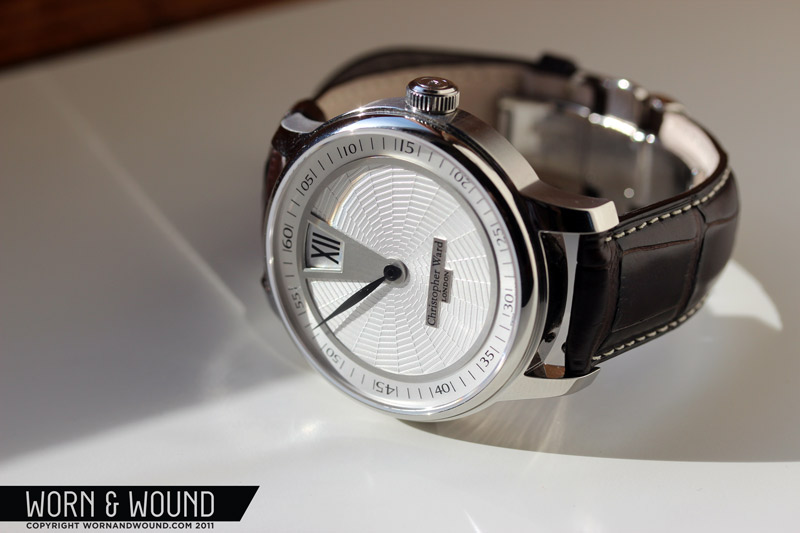

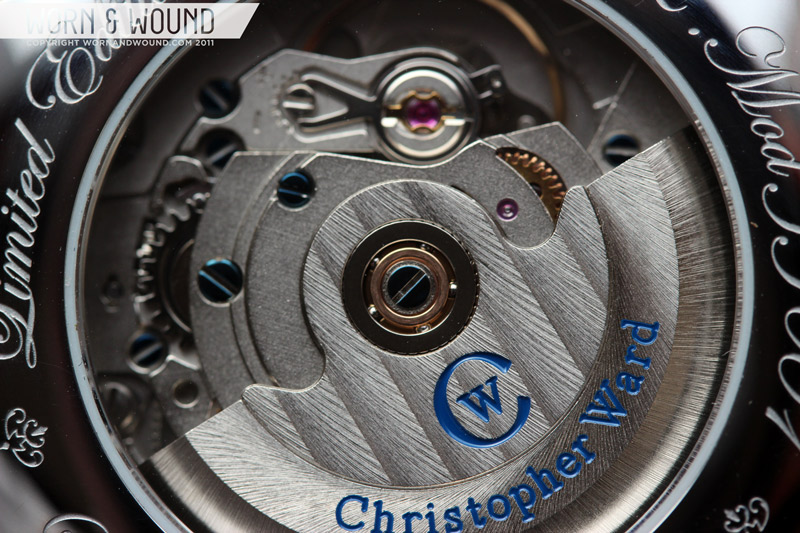
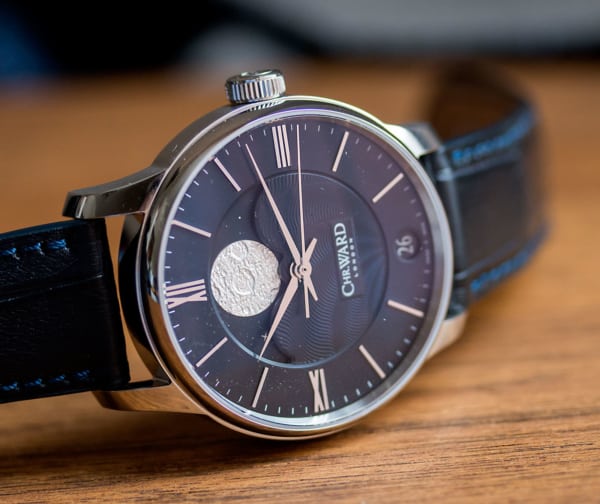
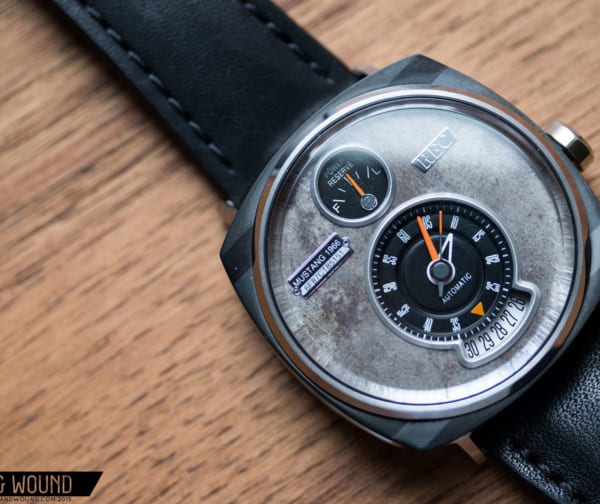

Great review! It really is a beautiful watch and that textured dial really makes it look worth it’s price.
What size wrist do you have? I am interested in this watch, but at 43mm is seems it will be too big for me, is the 43mm including the crown?
Hi Fernando,
The 43mm does not include the crown. I have a 7in wrist and did not find the watch to be too big, though I did have to put the strap on the last hole. That being said it is large for a dress watch.
Best,
Zach
thanks for the reply Zach. I have a 6.5 inch wrist so it will probably be too big for me which is a bummer because I really liked the watch after I saw your review, thanks for that btw.
I love the exhibition case back and clean aesthetic. If I was looking to step up my dress watch inventory, this would be a good contender.
Hi can you just let me know if its possible to purchase the Christopher Ward C9 Harrison Jumping Watch.Or if you know anyone that is selling this watch.
Many Thanks
Pamela Smith